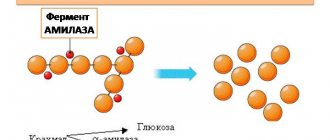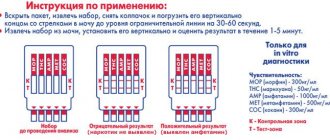Protein norm
Protein excretion in urine is not normal.
Normally, urine contains only traces of this substance. Indeed, during filtration in the kidneys, the glomerular system prevents protein from entering the urine. However, this only applies to molecules of high molecular weight, but proteins with small molecular weights can pass through such a barrier. In the proximal tubules, the predominant percentage of proteins is absorbed into the blood, only a small part is excreted. The excretion of proteins in urine indicates a malfunction of the mechanism of the glomerular filtration system at the site of identification of charge or volume in protein molecules, which can become an initiating factor for nephrotic syndrome. Sometimes protein appears in urine due to impaired reabsorption due to autoimmune diseases, poisoning, and drug intoxication. The increased protein content in urine can also be explained by a high level of protein particles in the blood due to massive muscle destruction, in myeloma, in the case of hemolysis.
It turns out that the determination of traces of protein in urine can be without pathology. But this value should not exceed more than 0.033 grams per liter in the morning portion of urine. This phenomenon occurs during heavy physical exertion, when consuming large amounts of protein foods, and during fever. Such proteinuria does not require therapeutic measures.
There is proteinuria of a pathological nature, the amount of protein exceeds the above value. This phenomenon occurs with glomerulonephritis, pyelonephritis, cystitis, prostatitis, and nephropathy of pregnancy. In this situation, it is very difficult to estimate the actual amount of protein that is lost in 24 hours based on just one urination. That is why a daily urine test for protein is prescribed.
The norm of proteins in urine in children
Children without diseases should also not have protein molecules in their urine. But the level of protein in urine up to 0.035 g is also considered normal. per liter Such numbers may arise for physiological reasons; they are not a reason to panic. A protein content of more than one gram per liter indicates a moderate degree of increase, and more than three indicates a high degree. High and moderate degrees require a detailed approach to diagnosis.
The principle of urine collection in children is the same as in adults.
Types of laboratory diagnostics of urine
There are different types of urine tests:
:
- general;
- according to Nechiporenko;
- urine protein test;
- microscopic examination;
- measuring glucosuria (glucose level in urine).
Go to analyzes
Depending on the pathology, one or another type of study is prescribed. A general urine test is indicated for any disease, as it is a general clinical research method that is routine. Urine tests must be assessed comprehensively, based on blood test data, instrumental research methods, and the general condition of the patient. If necessary, the analysis is prescribed over time. This is especially true for urological and nephrological patients. A urine test is of great importance for those who have undergone surgery and are undergoing detoxification. Regular checking of urine test data is important when assessing treatment and for its correction, if necessary.
Let's look at each technique in more detail.
General urine analysis
One of the main research methods used in medical practice. Based on the fact that urine is a complex solution of minerals, salts and organic substances. There are thousands of substances dissolved in water, which makes up most of urine. To a greater extent, urea and sodium chloride are excreted in the urine. Otherwise, even in healthy people, the composition of urine is constantly changing. The general analysis includes an assessment of transparency, acidity, and density. The amount of basic elements of sediment is studied - the level of protein, glucose, ketone bodies, blood cells, pigments.
A general urine test allows you to monitor and adjust treatment and provides comprehensive information about what processes are occurring in the body. It is quick to implement and does not require complex equipment, which is why it is widespread and often used.
A general urine test does not require special preparation. In urgent cases, collection is carried out, regardless of the patient’s preparation.
Urinalysis according to Nechiporenko
The technique was proposed by a specialist urologist, Nechiporenko A.Z. The peculiarity of the method is that the calculation of the studied parameters is carried out not in the field of view, as in a general analysis, but in a unit of urine. The technique is highly informative, does not require significant costs and time, is possible with a small amount of urine and does not require special preparation.
It is used as a clarification of the general analysis if it shows deviations. Some indicators are not thoroughly covered by the general analysis and more detailed research is required. It does not replace general analysis, but complements it. Widely used in urology, therapy, surgery and nephrology.
A urine test according to Nechiporenko is prescribed if traces of blood, leukocytes, and traces of protein are found in the general analysis. The technique is informative in the diagnosis and treatment of various diseases of the kidneys and urinary system. Using the analysis, the number of red blood cells, leukocytes, and cylinders changes. The composition of the cylinders and their structure are assessed.
Measuring protein levels in urine
The protein that is excreted from the body in urine is only traces of the total amount of protein that is filtered daily and reabsorbed back into the kidney structures. Sometimes, protein increases based on functional changes, even in healthy people. This is observed with changes in blood circulation indicators, acute diseases, and temperature changes. Functional proteinuria disappears simultaneously with the cause that caused it.
Proteinuria - the content of protein in the urine, indicates a decrease in the normal function of the kidneys to retain protein in the body. This may be increased filtration or decreased reabsorption. Also, protein may initially be elevated in the body, and its excess is excreted in the urine.
Microscopic urine analysis
This method allows you to study organized and unorganized urine sediment, assess the quantity and quality of cylinders. We are talking about more than ten indicators. Epithelial cells and cylinders, blood cells, are taken into account. From unorganized sediment, the level of salts, ions, and minerals is measured. Most often, the level of urates, phosphates and oxalates is studied. An increase in these indicators may indicate serious metabolic disorders and diseases.
By cylinders we mean casts of the urinary tract, which are formed from various substances - hyaline, red blood cells, epithelium. They form in the renal tubules and indicate problems with the functioning of the kidneys, as well as general changes in the body.
Assessing urine glucose levels
Normally, urine contains a low concentration of glucose. It is not detected using standard research methods, therefore the norms of indicators correspond to the absence of glucose in the urine. If glucose is detected in urine, it is called glycosuria. Most often, this is associated with an increase in glucose in the body (hyperglycemia). It’s not scary if glucose increases with high carbohydrate consumption or taking certain medications. It happens that glucose in the blood is at a normal level, but its concentration in the urine is increased - this happens in some pathologies, during gestation. The consumption of carbohydrates and the volume of urine excreted from the body per day must be taken into account; this makes the analysis more objective.
Types of proteinuria
The main factor influencing the appearance of protein compounds in urine is problems in the absorption of this substance. Proteinuria is distinguished:
- Canalicular. In some diseases, protein absorption is impossible or difficult.
- Glomerular. In this case, protein molecules are not retained and are excreted along with the liquid. This phenomenon is typical for the following pathologies: pyelonephritis, kidney damage from toxins, glomerulonephritis.
- Extrarenal. There are damage to the urinary tract, characteristic of urethritis, colpitis and cystitis.
To determine the type of proteinuria, microscopic examination is used. Further, if necessary, the doctor prescribes other types of examinations, including ultrasound, magnetic resonance imaging and other hardware methods.
What does such an analysis provide?
Based on such an examination, the presence of a number of pathologies can be assumed. But it is worth noting that an accurate diagnosis requires a more detailed and thorough study using other laboratory and instrumental techniques. The presence of protein in the urine may indicate:
What does protein in urine mean?
- decompensation of diabetes mellitus;
- kidney failure;
- amyloidosis;
- cardiac ischemia;
- connective tissue diseases;
- lipoid nephrosis;
- Fanconi syndrome;
- glomerulonephritis and pyelonephritis;
- hypertension;
- malignant diseases.
Also, protein excretion in urine is possible in case of diseases of the respiratory system and gastrointestinal tract. Also of great importance is the so-called selective proteinuria. In this case, a certain type of protein is released, usually albumin. If this type of protein is elevated in the urine, then pathology of the kidneys or the cardiovascular system can be assumed.
Catalog of containers for biomaterials
| Image | Name | Volume | Sterility | Spoon |
| Container for biomaterials 120 ml, sterile | 120 ml | — | ||
| Container for biomaterials 100 ml, non-sterile | 100 ml | — | ||
| Container for biomaterials 60 ml, non-sterile, without spoon | 60 ml | — | ||
| Container for biomaterials 60 ml, non-sterile, with spoon | 60 ml | |||
| Container for biomaterials 60 ml, sterile, without spoon | 60 ml | — | ||
| Container for biomaterials 60 ml, sterile, with spoon | 60 ml | |||
| Container for biomaterials 30 ml, non-sterile, without spoon | 30 ml | — | ||
| Container for biomaterials 30 ml, non-sterile, with spoon | 30 ml | |||
| Container for biomaterials 30 ml, sterile, without spoon | 30 ml | — | ||
| Container for biomaterials 30 ml, sterile, with spoon | 30 ml |
To obtain high-quality results from medical tests, not only blood collection must be standardized, but also the collection of other types of biomaterials, such as urine and feces. Today, the use of household containers is unacceptable; research material must be delivered in disposable plastic containers.
The main properties of urine and pathologies in which they change
The main indicators of urine include:
- amount of daily urine;
- color;
- transparency;
- smell;
- acidity;
- specific gravity.
Let's take a closer look at these indicators.
Volume
Normally, the volume of a urine portion is 100-300 ml. A low amount of urine volume indicates kidney failure and dehydration. Polyuria is an increase in urine volume, which may indicate the presence of diabetes, pyelonephritis and other conditions. There is oliguria - the daily amount of urine is up to 500 ml. It occurs with pathologies of the heart and kidneys. There is also anuria - the daily amount of urine is up to 200 ml. This is a serious condition that occurs in cancer, meningitis, and acute kidney failure.
In addition to the volume of urine, the nature of urination is assessed. This may be a predominance of nighttime diuresis over daytime, although normally it should be the other way around. Deviations include small and frequent portions of urine, painful urination, involuntary acts and false urges. It is necessary to evaluate these indicators comprehensively, because they form a complete clinical picture.
Color
Normal urine is straw-yellow in color. You can tell a lot by the color change. For example, the orange tint is given by bile pigments, which increase in the urine with hepatitis, cirrhosis, and bile outflow disorders. Red color is observed when there is an increase in red blood cells in the urine. This accompanies pyelonephritis, the passage of kidney stones, cancer, tuberculosis. A greenish-white color is observed when interspersed with pus. Black urine occurs due to poisoning. intoxications. Urine may be brown, it is also compared to the color of beer - this occurs due to disturbances in the exchange of bile pigments, dehydration, and the consumption of certain foods and chemicals.
The color of urine may change depending on food and medications. Normal color does not exclude changes and pathology, but a violation of this indicator clearly indicates a problem.
Smell
Under some conditions, urine changes its odor. For example, when it is inflamed, it smells like ammonia. Diabetic patients experience a slight odor of acetone. The normal smell of urine is specific, but not sharp, without additional shades. This indicator is not specific and is not widely used. Rather, this is an indicator that can alert the patient and serve as a reason to consult a doctor.
Availability of foam
There should be no foam in the urine. It can appear with jaundice, increased protein levels, diabetes and other metabolic disorders.
Transparency
Normally, urine should be clear. It becomes cloudy if it contains admixtures of pus, salts, a large amount of mucus or formed elements. This is observed in infectious diseases. In laboratory conditions, various reagents are used and they study which one will make urine clear. For this purpose, acids, alcohol, and heat are used. The effectiveness of a particular method indicates what caused the cloudy urine.
Density
An increase in the indicator indicates a decrease in water in the body, and a decrease indicates kidney pathology. The norm is 1018-1025 units. The density level is affected by the amount of protein, glucose, sediment, and the presence of bacteria. Low density is observed in diabetes, renal failure, hypertension, and the use of diuretics. High density is observed with various intoxications and edema.
Acidity of urine
The normal urine pH is 5-7, that is, slightly acidic or neutral. A more acidic environment is observed with tuberculosis, nephritis, gout, and acidotic changes in the body. Also, acidic urine is observed with increased consumption of animal proteins and certain medications.
An alkaline reaction accompanies a high amount of vegetables in the diet, consumption of alkaline mineral waters, hyperkalemia, alkalosis, and inflammatory diseases.
Causes of High Protein Levels
What is the reason for the increase in protein compounds? To date, many diseases have been identified that can cause proteinuria. These include:
- systemic connective tissue pathologies (lupus);
- type diabetes;
- multiple myeloma;
- progressive hypertension;
- kidney diseases;
- malignant neoplasms.
Also, a similar effect occurs due to chemotherapy procedures; mechanical injuries; burns of varying severity; intoxication of the body; hypothermia.
Protein penetrates into the blood in three ways. The first involves increased blood flow; this phenomenon does not require treatment. The second is damage to the basement membrane. The enlargement of its openings promotes the release of proteins into the tubules and further into the urine. In the third case, the filtration surface is fine, the problem is localized in the kidney tubules, which do not return the protein required to maintain the body normally.
Types and characteristics of stool containers
Containers for collecting stool, necessary for laboratory tests of a general clinical nature, are made of durable, ultra-pure polymer materials. The plastic used for this purpose is resistant to mechanical stress and neutral with respect to chemically active media. The container is made of polypropylene, the lid is made of polyethylene. A spatula is built into the lid. The volume of containers for collecting this biomaterial is from 30 to 60 ml.
Advantages of using different types of special containers for collecting stool samples
- the likelihood of penetration of foreign substances is minimized;
- the period during which the biomaterial remains suitable for qualitative analysis is significantly extended;
- the container closes securely;
- the container is equipped with a spatula intended for taking biological material for analysis;
- There is a label on the wall of the container for recording patient information.
Analysis in pregnant women
Since women in this position significantly increase the load on their kidneys, they often experience swelling, shortness of breath, weakness, and sudden weight gain. In such cases, the doctor suggests collecting daily urine. This analysis should be done once every 48 hours. If the protein is detected, then hospital therapy is recommended for the pregnant woman. Daily urine protein is also often done during the second screening during pregnancy (this is 22-24 weeks of gestation). This is a kind of preventive measure for the early detection of pathology.









